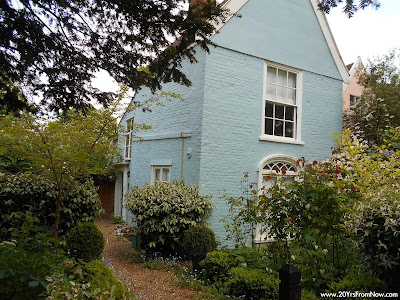Our Attleborough housesit allowed us plenty of opportunity to explore the surrounding countryside and travelling via the Abellio Greater Anglia train line (thank you, Chris!) made the journey both enjoyable and easy. Norwich is a short hop from Attleborough and the entire train trip takes under 25 minutes one way. The Norwich train station (below) is conveniently located on the River Wensum.
Kitty-corner from the train station is this restaurant/pub that invites one to sit a spell, savour the great view of the river and passing boats.
Further along is Bishops Bridge built in 1340. Still in use, it is one of the oldest bridges in England.
Norwich's outdoor market is the largest in the country and open Monday through Saturday.
Our primary reason for visiting Norwich, however, was the cathedral and its spire (second highest in England) is visible in the background below.
We managed to find our way by continuing seeking out the spire and along the way I admired the varied homes and architecture.
Construction on Norwich Cathedral began in 1096.
It is one of the finest medieval churches in Europe.
The more than 1000 roof bosses depict the biblical story of Creation through to the Day of Judgment, but also feature many non-Christian symbols and images. These include Green Men, beasts, kings, nobles, peasants, musicians, Popes, soldiers, a stonemason, acrobat, merchants, carpenters and ladies with fanciful headdresses. For this reason Norwich Cathedral has been called "one of the greatest hidden glories of medieval art."
The detailed stone carvings, ornate wooden decorations are also impressive.
This particular painting remained undiscovered for centuries. Turned upside down and the back used as a table it remained hidden from view until someone happened to look underneath. Rumor is it became a table top to save it during the Reformation.
The stained glass windows also deserve mention. They are some of the finest examples we've seen during our travels.
Our next stop - Norwich Castle - built by the Normans 900 years ago as a royal palace.
The interior is large and spacious and features many historical objects.
Including the Norwich Dragon, affectionally called Snap. Originally created by members of the Guild of St. George (founded in 1385) Snap paraded the streets of Norwich during the inauguration of the Mayor. He was a source of entertainment, but also a promise the Mayor would slay dragons if necessary for his constituents. (Notice Snap's feet.)
This plague was found on the Norwich Castle Grounds.
I also discovered another plaque on the Castle walls that seem rather fitting. "My road calls me, lures me west, east, south and north. Most roads lead men homewards, my road leads me forth."
Although this particular time the road did lead homeward and within seconds John and George crashed on the sofa!
* * *








































